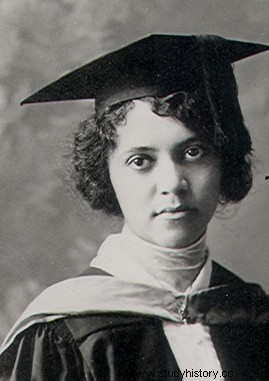American chemist, Alice Ball ( – ) developed a cure for leprosy despite the tragic shortness of his career. She is the first woman and first African American to graduate from the University of Hawaii.
Brilliant studies
 Born July 24, 1892 in Seattle, Alice Augusta Ball was one of four children of Laura Louise Howard Ball and James Presley, publisher, photographer and jurist. She is the granddaughter of James Presley Ball [English], a famous photographer and one of the first African Americans to master the daguerreotype. In 1903, the family moved to Hawaii in hopes that the climate would relieve Alice's grandfather's arthritis, but he soon died and the family returned to Seattle as early as 1905.
Born July 24, 1892 in Seattle, Alice Augusta Ball was one of four children of Laura Louise Howard Ball and James Presley, publisher, photographer and jurist. She is the granddaughter of James Presley Ball [English], a famous photographer and one of the first African Americans to master the daguerreotype. In 1903, the family moved to Hawaii in hopes that the climate would relieve Alice's grandfather's arthritis, but he soon died and the family returned to Seattle as early as 1905.
Young Alice attends Seattle High School where she quickly distinguished herself in scientific subjects. After graduating in 1910, she studied chemistry at the University of Washington; she graduated there in pharmaceutical chemistry and then in pharmacy. During her studies, she co-published with a professor a ten-page article in the prestigious scientific journal Journal of the American Chemical Society . It was a rare achievement for a woman at the time, and even more so for a black woman in the United States.
After her brilliant studies, Alice receives many scholarship offers. She chose to do a master's degree in chemistry at the University of Hawaii, from which she would be the first woman and the first African-American to graduate in 1915.
Ball's method
At the University of Hawaii, Alice Ball is working alongside Dr. Harry T. Hollmann on the properties of chaulmoogra oil, used in the treatment of leprosy. At the time, leprosy patients were sent to the Hawaiian island of Molokai, and treated with chaulmoogra oil. The remedy has a severe flaw:thick and sticky, the oil is not effective when applied externally and painful when injected, forming blisters under the skin. And its acrid taste, making patients vomit, prevents it from being used by ingestion.
Barely 23 years old, Alice developed a technique to isolate the fatty acid ethyl ester from chaulmoogra oil and make it water soluble. Known as “the Ball method”, this process makes it possible to make the remedy injectable and avoid problems related to ingestion or blisters forming under the skin.
Inheritance
During her research, Alice Ball falls seriously ill. Returning to Seattle for treatment, she died there in December 1916 at the age of 24. According to her – amended – death certificate, she succumbed to tuberculosis, but it could rather be chlorine poisoning contracted during a teaching session.
Arthur L. Dean, chemist and president of the University of Hawaii, continues Alice Ball's work, publishes the results and produces injectable chaulmoogra extract; he will go so far as to rename the process "Dean's method", until Harry T. Hollmann establishes the truth. In 1918, a Hawaiian doctor reported that 78 leprosy patients were discharged from hospital after receiving the treatment developed by Alice Ball. Remedy that will remain the most effective until the 1940s.
